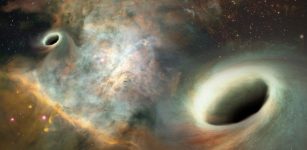Spitzer Space Telescope’s New Image Of Beautiful Spider Nebula Glowing Green
MessageToEagle.com – A new image from NASA’s Spitzer Space Telescope presents the Spider Nebula, officially named IC 417, that lies near a much smaller object called NGC 1931 not pictured in the image. Together, the two are called “The Spider and the Fly” nebulae.
Nebulae are clouds of interstellar gas and dust where stars can form.
The Spider, located about 10,000 light-years from Earth in the constellation Auriga, is clearly a site of star formation. It resides in the outer part of the Milky Way, almost exactly in the opposite direction from the galactic center.

Toward the right of center, against the black background of space, you can see a bright group of stars called “Stock 8.” The light from this cluster carves out a bowl in the nearby dust clouds, seen in the image as green fluff. Along the sinuous tail in the center, and to the left, the groupings of red point sources clumped in the green are also young stars.
In the image, infrared wavelengths, which are invisible to the unaided eye, have been assigned visible colors. Light with a wavelength of 1.2 microns, detected by 2MASS, is shown in blue. The Spitzer wavelengths of 3.6 and 4.5 microns are green and red, respectively.
Spitzer data used to create the image were obtained during the space telescope’s “warm mission” phase, following its depletion of coolant in mid-2009.
Due to its design, Spitzer remains cold enough to operate efficiently at two channels of infrared light. It is now in its 12th year of operation since launch.
MessageToEagle.com
Expand for references









